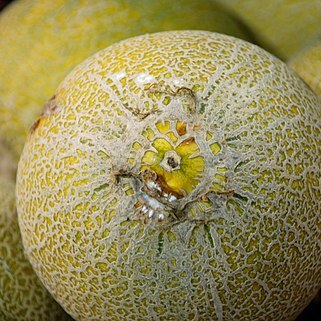Medium-sized climbing or trailing herbs; stem annual, usually ± hispid-or scabrid-hairy. Leaves simple, palmately lobed, petiolate. Tendrils simple. Flowers small to medium-sized, yellow, monoecious, rarely dioecious. Male flowers solitary or in few-flowered sessile or pedunculate groups; receptacle-tube campanulate; lobes small, filiform: petals united below; stamens 3, 2 double 2-thecous, 1 single 1-thecous, shortly inserted about the middle of the tube; filaments and anthers free; connective apically produced; thecae triplicate; disk obconic or subglobose, basal, free from the tube. Female flowers usually solitary; ovary hairy, the hairs often apical on small soft papillae or aculei; ovules many, horizontal; perianth as in ♂ flower; staminodes often present, 3, subulate, inserted on the tube; disk annular, surrounding base of style, free from tube; stigma 3-lobed. Fruit fleshy, usually rather firm-walled, indehiscent, smooth and glabrous or ± uniformly pubescent or more often with dense to scattered fleshy spines, pustules or tubercles each of which ends in a ± broad-based hyaline bristle or the basal remnants thereof, red, yellow, greenish or sometimes brownish, rarely maturing underground. Seeds small to medium-sized, lenticular, light-coloured, elliptic in outline and usually rather more pointed at the proximal end. Figs. 15, 16, (p. 101).
Small or medium-sized annual or subperennial climbers (rarely suberect), leafy stem 1-4 mm diam., plant scabrous or setose; monoecious (rarely dioecious); usually cultivated. Probract absent. Tendrils unbranched. Leaves simple. Flowers yellow, solitary or few-fascicled; pedicels short; corolla composed of partly fused petals, small-or medium-sized. Male flowers: receptacle-tube campanulate or turbinate, small; sepals mostly linear; petals (corolla) with margin entire; stamens 3, free, inserted about halfway the receptacle-tube, filaments short, anthers two 2-thecous, one 1-thecous, thecae sinuate, 3-plicate or S-shaped, connective considerably produced; disc large, gland-like, free from the tube. Female flowers usually solitary; ovary hairy, hairs sometimes apical on small protuberances, ovules numerous, horizontal; perianth as in male flowers but somewhat larger, stigma 3-lobed, lobes lobulate; staminodes often present, small; disc surrounding base of style, free from the tube. Fruit a (large) pepo (fleshy berry), indehiscent, pubescent or glabrous, or with fleshy spines or tubercles, green, yellow or orange (rarely maturing underground in C. humifructus, southern Africa). Seeds numerous, pale, compressed, (narrowly) elliptic, not sculptured, unmargined with entire, acute edge, not winged (or rarely winged).
Monoecious, trailing, tendriled vines; stems 5-to 10-sulcate. Leaves petiolate, lobed or angular; tendrils simple, sometimes straight and spinescent. Staminate flowers axillary; fasciculate or solitary; calyx turbinate or campanulate, 5-lobate; corolla campanulate, 5-lobate; stamens 3, borne on the hypanthium wall, the filaments free, stout, the anthers curved or flexuous, one anther unilocular, the other anthers bilocular, connective with 2-lobed appendage; pistillodium gland-like. Pistillate flowers similarly disposed as the staminate flowers; calyx and co-rolla as in the staminate flowers; ovary globose or oblong, 3-carpellate, the styles 3-5, connate, short, the stigmas connate, 3-5, forming a spherical or obovate head; staminodia 3, small. Fruits fleshy, the surface smooth or roughened, usually indehiscent; seeds numerous, horizontal, ovate to oblong, compressed, emarginate, the testa smooth.
Monoecious or dioecious climbing or trailing annual or perennial herbs, usually hispid. Tendrils simple. Leaves simple, dentate to deeply palmately lobed. Flowers rarely bisexual. Male flowers solitary or in fascicles, racemes or pedunculate groups; hypanthium campanulate; calyx 5-lobed, the lobes subulate to narrowly lanceolate; corolla deeply 5-lobed, the lobes lanceolate to ovate, yellow; stamens 3, inserted about middle of hypanthium; connective with expanded appendages; anthers two bilocular, one unilocular; locules flexuose, triplicate; disc gland-like. Female flowers solitary, rarely fascicled, sometimes co-axillary with males; perianth similar to males; staminodes 3, subulate, rarely absent; ovary globose to ellipsoidal, pubescent; ovules many; style inserted in annular disc; stigma 3-lobed. Fruit ellipsoidal, fleshy, indehiscent. Seeds many, elliptic, compressed, smooth, pale.
Herbs, scandent or creeping, annual. Stem and branches scabrous, hispid. Tendrils slender, simple. Leaf blade almost orbicular, reniform, or cordate-ovate, undivided or palmately 3-7-lobed. Plants monoecious, rarely dioecious, or flowers hermaphroditic. Male flowers fascicled or solitary; calyx tube campanulate, 5-lobed; segments subulate; corolla rotate or subcampanulate, 5-lobed; segments oblong or ovate; stamens 3, free, inserted on corolla tube; anthers oblong, one 1-celled, two 2-celled; anther cells linear, reflexed or curved; connective produced; rudimentary ovary glandular. Female flowers solitary or fascicled; calyx and corolla as in male flowers; staminodes 3, subulate; ovary cylindric; ovules numerous, horizontal; style short; stigmas 3-5. Fruit polymorphic, fleshy, indehiscent, smooth or verrucose. Seeds numerous, compressed, emarginate.
Female flowers usually solitary, pedicellate; ovary smooth and densely pubescent or setulose, or covered with soft apically setulose spines or tubercules; ovules numerous, horizontal; perianth as in male flower; staminodes often present, 3, subulate, inserted on receptacle-tube; disk annular, surrounding base of style, free from receptacle-tube; stigma 3-lobed.
Fruit usually ellipsoid, oblong-ellipsoid or subglobose, smooth and pubescent to glabrous or usually with dense to scattered apically setiferous spines, tubercules or pustules, firm-walled, fleshy, indehiscent, rarely geocarpic, usually yellowish when ripe, sometimes reddish, often longitudinally striped.
Flowers small to medium or rarely rather large, yellow or pale yellow, monoecious or dioecious, male flowers solitary or in few-flowered axillary fascicles; receptacle-tube campanulate or obconic, ± setulose, lobes usually linear, small.
Stamens 3, two double 2-thecous, one single 1-thecous; filaments short, inserted on receptacle-tube, free; anthers free; connective more or less produced; thecae triplicate.
Annual or perennial herbs, the latter with thickened or tuberous rootstock; stems annual, prostrate or scandent.
Seeds ovate or elliptic in outline, usually smooth, compressed.
Tendrils simple, rarely more than one at each node.
Disk basal, subglobose, free from receptacle-tube.
Corolla-lobes 5, united near the base.
Leaves simple, petiolate.


